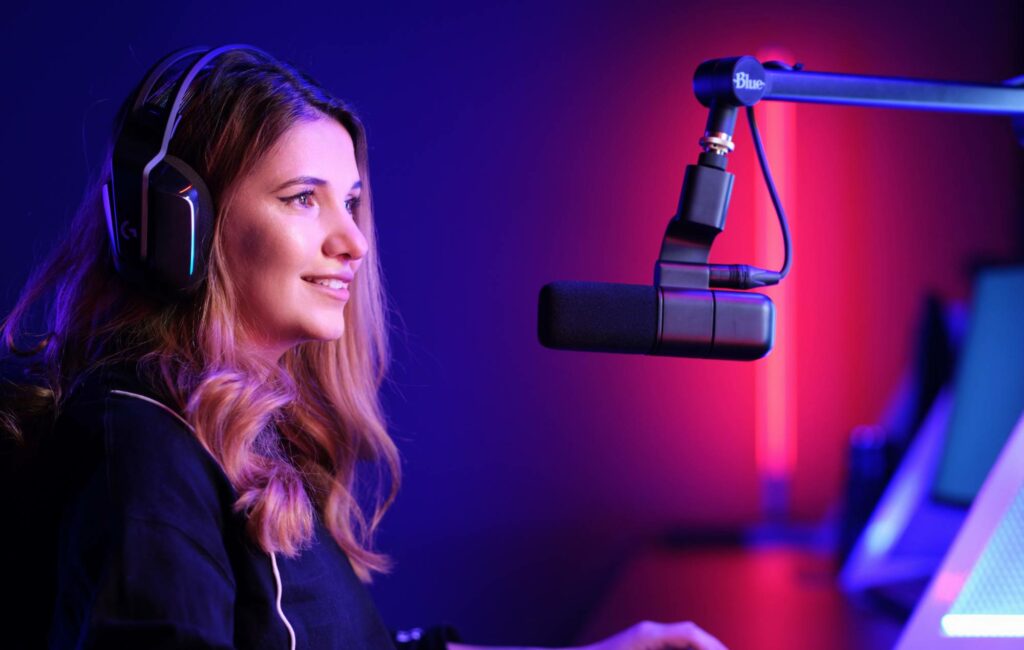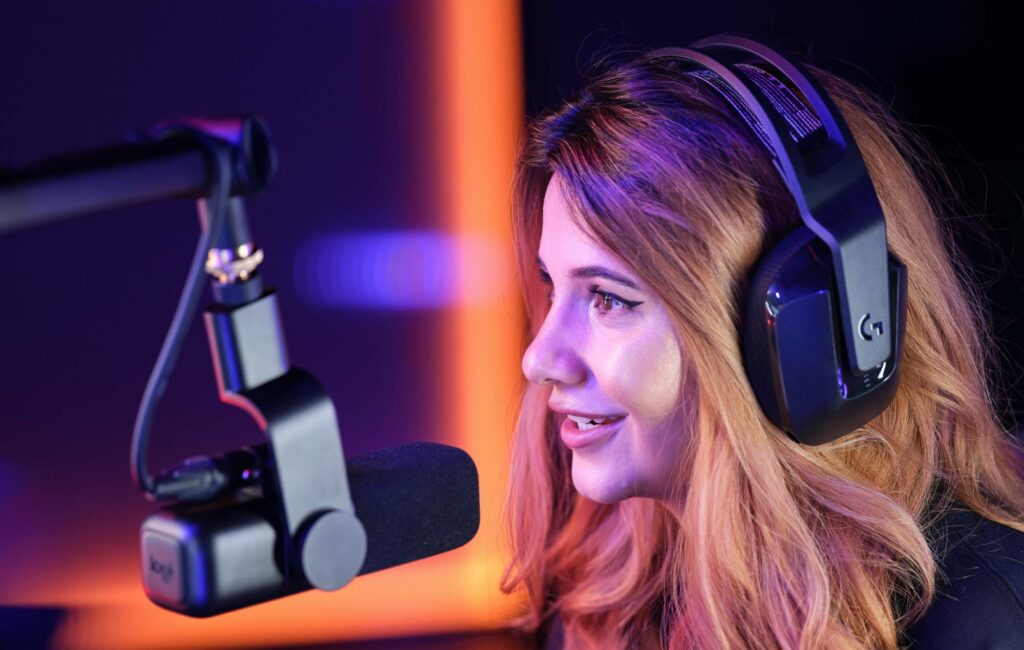Looking for a new microphone? Why Logitech could provide the answer
Need a new microphone? Look no further.
By Brit Dawson

Where once to establish yourself as a vlogger or streamer, all you needed was a computer and a YouTube login (and, depending on how far back we’re going, a webcam) – now, things are a little more professional. You’ll be hard pushed to find any kind of content creator without a proper camera, stabiliser, decent lighting, or a good quality microphone.
When it comes to the latter, it can feel like a minefield trying to figure out which one’s right for you. There’s so many words you’ve never heard of, extra equipment you could invest in, and different mics for different specific sound outputs. So, to help fledgling creators, we’ve put together a guide to the main kinds of microphones out there.
But, before we get into the specifics, it’s worth considering your budget, intention, and recording space. The kind of content you’re making will have an influence on which mic you should buy – and thus how much you need to spend – so it’s worth narrowing down your big dreams to one smaller dream. Certain microphone types are better for music-making, for example, while others suit conversation or voiceovers (aka podcasts, streaming, or vlogging) better.
It’s also worth thinking about the location you’ll be recording in and the potential soundproofing you might need. Most novices will likely be setting up in their bedrooms, so you might want to invest in some soft furnishings and accessories that help with the acoustics, like rugs, a carpet, books, or even a tapestry on the wall. London-based producer and multi-instrumentalist Pastel has become an expert of sorts at getting the optimum out of an in-bedroom microphone. His key tip is to record away from the middle of the room. “It should always be a corner, or somewhere that can help reduce the noise and the reverb,” he explains. “And the more stuff you have [in your room], the better!”
Okay, now onto the microphone specifics. The first and possibly easiest thing to decide on is what kind of connectivity you want. And, luckily, there’s only really two to consider: USB or XLR. For those looking for convenience and ease of use, a so-called ‘plug-and-play’ USB microphone might be best suited to you. USB mics have an integrated analog to digital converter, so they can be plugged straight into your computer, meaning you won’t need to spend extra money on an audio interface – which is also a positive for portability. This tends to make USB mics the go-to for beginners, especially those who might be on a budget, regularly travelling, or who haven’t decided how committed they want to be to content creation yet.

XLR microphones, on the other hand, usually have an analog three-pin connector, which will need to be plugged into an audio interface (which then plugs into your computer) in order to convert the signal into a digital format the computer can understand. This structure also enhances sound quality by balancing the audio, thus reducing background noise. This is partly why XLR mics tend to be favoured for more professional recordings, along with the fact that they afford you more flexibility as you can continually upgrade your gear, rather than having to just buy a new microphone. What’s more, using an audio interface allows you to record more than one microphone at a time. So, say you were recording a podcast with several participants, using XLRs would mean you wouldn’t all have to huddle around one mic, which would improve the quality of the recording (and probably the enjoyment of the experience!).
Next, you’ll need to think about the type of mic you want. Again, there’s two main ones to weigh up: condenser vs dynamic. The former is more sensitive, and so tends to be used to capture quieter sounds more accurately and clearly – making it a better choice for ASMR creators, for example, who are looking to catch every detail of the voice. Condensers are also typically used by singers, particularly in studio environments. You may read about small vs large-diaphragms in relation to condenser mics, too (dynamics also have a diaphragm, but the size is less important). As well as affecting the actual size of the condenser mic, the size of the diaphragm has an impact on sound – a small diaphragm condenser will capture a more accurate, neutral sound (e.g. acoustic guitars, string instruments), while a large diaphragm condenser will give a bigger, warmer sound (e.g. vocals, voiceovers). Finally, condenser mics need electricity to work – either batteries or something called ‘phantom power’, which is usually a switch on your audio interface.
Dynamic mics don’t typically need a power source, and, as they’re less sensitive, they tend to be used for louder sounds, like live performances, as well as for vocals like interviews, voice recordings, or podcasts. This also makes them more forgiving of background noise, like an unavoidable sneeze or the rogue opening of a bedroom (see: home studio) door. Dynamic microphones also tend to be cheaper, more durable, and easier to set up.
Logitech’s’ Blue Sona is an XLR dynamic microphone – and one that’s specifically made for content creators. “As [creators], and game streamers especially, start to get more sophisticated, they need more refined equipment,” says Gabe Whyel, head of product marketing at the Logitech-owned audio production company Blue Microphones. “We saw a need for [creators] to have an elite level microphone that was really built for them.” Whyel explains that the previous mics typically available to creators were “broadcast-style” ones “designed for original radio stations decades ago”.
In order to make a mic specifically for online content creation, Blue Sona had to take a look at each element of a traditional XLR dynamic mic and create new technologies to make it fit for purpose. One of these is ClearAmp technology, which streamlines the experience for users. “With a typical dynamic microphone, you’d have to turn the mic gain all the way up in order to get a loud enough sound to be robust for your podcast,” says Whyel. “And when you turn the mic pre in your audio interface all the way up, it gets a graininess distortion. So, what a lot of people do is buy a mic pre, which they put between the microphone and the audio interface, and which brings up the volume level of the mic.” The ClearAmp technology boosts the signal coming out of the microphone, making it high enough to go straight into the audio interface – this effectively cuts out the middleman, simplifying your set-up and more easily giving you high quality sound.
Not just this, but, as Pastel can attest to, the Blue Sona is particularly good at reducing background noise, which, he says, is good for “creators like me who don’t necessarily work in studios, and only have a bedroom to [record in]”. “We all have noisy computers or housemates, but when you record, you want to be in the moment, so it has to be fast,” he continues. “If there’s good noise reduction in the mic, you don’t have to do many more treatments afterwards, [so the final edit can stay natural and spur-of-the-moment].”
The Logitech Blue Sona also just looks great – as it should, given it was designed to appeal to the current trend of content creators having their mics on camera. The mic’s sleek, simple design comes in two colourways, off-white and graphite for a particularly sophisticated on-camera look.
Hopefully this mini guide has been helpful on your journey to online stardom. Ultimately, as Whyel says, the best microphone for you comes down to your goals for the content you want to create – so, before you invest, it might be worth making an Apprentice-esque business plan. Good luck!
The Logitech Blue Sona XLR dynamic microphone (£299) is available via Logitech now.
